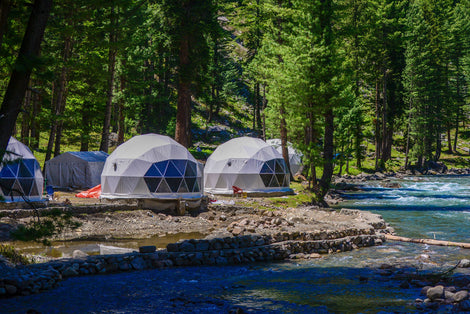Waste Management Solutions for Remote Living
Living off the grid comes with a lot of freedom, but it also brings daily challenges that city life tends to handle behind the scenes. One of the big ones? Waste. Whether you're settled into a remote cabin or moving around in a tiny home on wheels, figuring out how to manage waste without regular services can be tricky. And waste systems that don't work well can turn into a smelly, messy problem quickly.
Setting up a clean, sustainable waste solution doesn't just help avoid that mess. It also protects your surroundings and supports the kind of low-impact lifestyle that off-grid living stands for. Composting toilet systems are one of the most dependable ways to keep things simple and sanitary. They make it possible to live far from the grid while still staying clean and leaving less impact.
Understanding Composting Toilets
A composting toilet is a system that turns waste into compost. These toilets work without plumbing, flush water, or a connection to a sewer or septic tank. That alone makes them a great fit for homes where water is limited or where pipes aren’t easy to install. Instead of flushing, composting toilets collect waste and break it down over time through natural decomposition.
There are two common types of composting toilets:
- Self-contained models: Everything stays in one single unit. These are common for cabins, RVs, boats, and other small setups. They include collection bins for both solids and liquids and sometimes small fans to help with airflow and odors.
- Centralized systems: These transfer waste to a separate holding tank that’s either outdoors or in another room. They’re a better option for long-term living with more than one person.
The benefits go well beyond just saving water. Composting toilets reduce wastewater runoff and don’t require harsh chemicals to treat waste. When maintained properly, they create nutrient-rich compost that can be used safely in landscapes or flower gardens. For anyone wanting to shrink their impact, composting toilets offer a smart and eco-friendly solution.
One real-world example comes from a couple living in a forest cabin year-round. They upgraded from an old-fashioned outhouse to a self-contained composting toilet. The change helped cut down on smells, saved water, and let them manage waste with a lot less effort.
Installation and Setup
Installing a composting toilet system at home isn’t very difficult, but setting it up correctly does make things easier in the long run. Your first step should be deciding where the system will go. A self-contained unit needs a private, well-ventilated space inside the home. A centralized model will require two spaces—one for the toilet and one for the tank.
Here are the usual steps to get started:
1. Choose the right model for your setup. Self-contained toilets are quicker to install. Centralized options need more space and planning.
2. Pick a location that stays warm when possible, since composting slows down in cold weather. Proper ventilation is key, using either a fan or passive vent.
3. Get the area ready. The floor should be flat and sturdy. Some models may need extra framing or support for vent piping.
4. Set up the vent system. Most composting toilets include a fan or vent pipe that directs air outside. This may mean cutting a small opening through a wall or roof.
5. If your toilet separates liquids, you may need a drainage pipe to lead to a small graywater pit, or a separate container for manual emptying.
6. Follow the manufacturer’s instructions carefully. Check seals and make sure airflow is clear and functioning.
For most homeowners, installation takes one or two days. You’ll need some basic tools like a level, power drill, saw (for cutting a vent hole), and a wrench. If your system uses an electric fan, think about how you'll power it, especially if you're completely off-grid.
Planning your layout ahead of time helps avoid future issues. And even in tight spaces, compact toilets can work great as long as they have airflow and are fitted correctly.
Maintenance and Best Practices
Keeping your composting toilet running the way it should comes down to regular upkeep and smart habits. Most systems are low stress once you get used to them, but they still need a watchful eye.
Here’s what to do to keep things running:
- Empty solids when the chamber gets full. Most models hold enough for a few weeks depending on use. Overfilling can slow down decomposition.
- Use a carbon material like sawdust, peat moss, or coconut coir after each solid use. This keeps moisture balanced and prevents odor.
- Always make sure the vent system is working and free of dirt, snow, or fallen leaves.
- If your toilet separates liquids, rinse out the container every few days. A vinegar-water mix can help keep it fresh and clean.
- Keep an eye on the compost’s moisture. It should feel damp, not soaked or dry. If it's too wet, add more dry cover materials. If it's too dry, reduce your cover material slightly.
If something smells off, it usually means there's too much moisture or the vent needs checking. In colder weather, composting may slow down, which is normal as long as the system isn’t overloaded.
You may run into small issues like flies. These can be caused by waste sitting too long or stale airflow. Keep vents screened and wipe down seals regularly. If needed, change the mix to a drier material and make sure no light is sneaking in through the vent pipe.
Treat your composting toilet like any other home system. A bit of care on a regular schedule keeps it running smoothly. Most people report that within a few weeks, upkeep feels easy and routine.
How Composting Toilets Support Off-Grid Living
Living off-grid usually means relying less on city networks and more on smart, local solutions. Composting toilets check both of those boxes. They allow you to manage waste on-site, giving you better control and peace of mind.
Teamed up with off-grid solar kits, these toilets become part of a wider setup that works well without outside services. No water lines. No flush tanks. No need to worry about freezing pipes on cold days. Plus, you remove the need for leach fields or septic service, which can be costly and tough to set up in hard-to-reach locations.
Imagine a solar-powered cabin tucked in the woods, a few hours from the closest utility service. With a composting toilet and some basic solar power, you can cook, clean, and take care of hygiene with less stress and fewer trips into town. That’s a big win for self-reliant homeowners.
You can even put the finished compost to use. It’s not for food gardens, but it can help feed the roots of trees, shrubs, and native plants. That turns waste into something helpful instead of just something to throw away.
Why This Waste System Just Makes Sense
Choosing a composting toilet system for home use while living off-grid isn’t just about avoiding mess. It’s about working smarter and living cleaner. These systems don’t need lot of space or water, and they give back in real ways.
Whether you’re setting up a weekend hunting shack, building a full-time homestead, or converting a camper, composting toilets give you one less thing to worry about. They work in lots of spaces, through all seasons, and with just a little bit of ongoing care.
You save water. You reduce your footprint. You get a steady, manageable way to deal with one of life’s daily needs. Composting toilets fit the idea of off-grid living: low stress, low impact, and more freedom with how you run your home.
Thinking about enhancing your off-grid setup? Explore how integrating a composting toilet system for home use can be complemented with other sustainable solutions. Check out our range of off-grid solar kits to see how Green Vista Living can help you create a more self-sufficient and environmentally friendly lifestyle.







